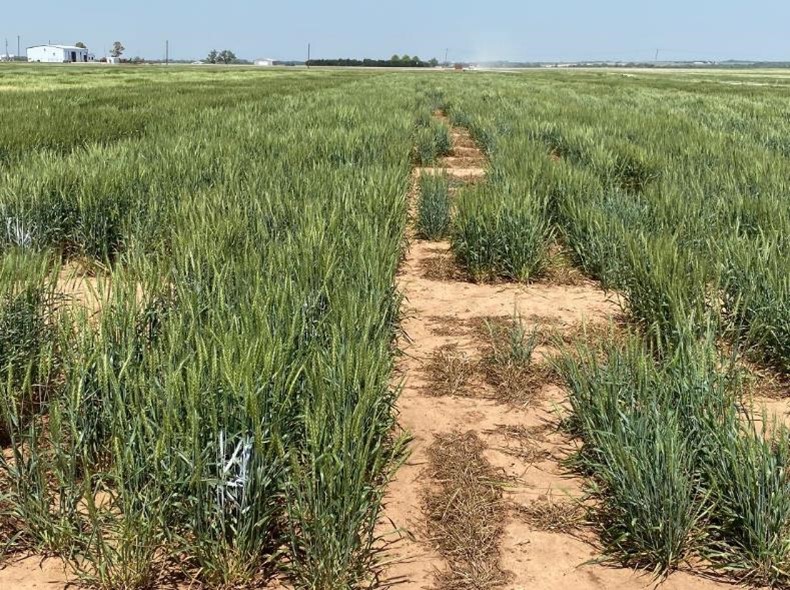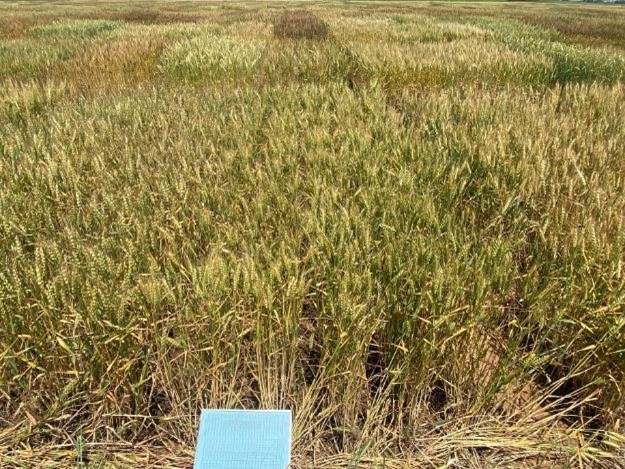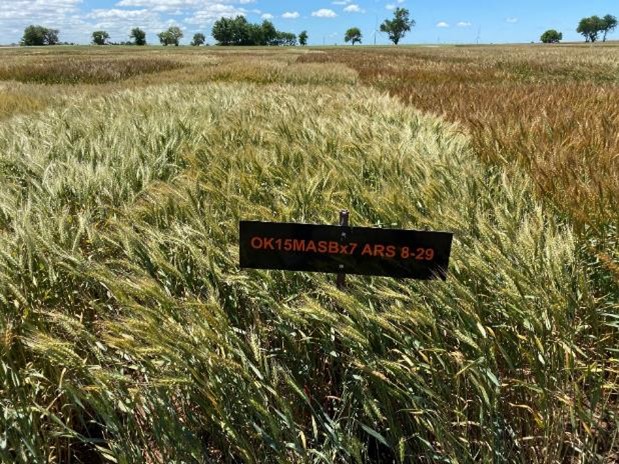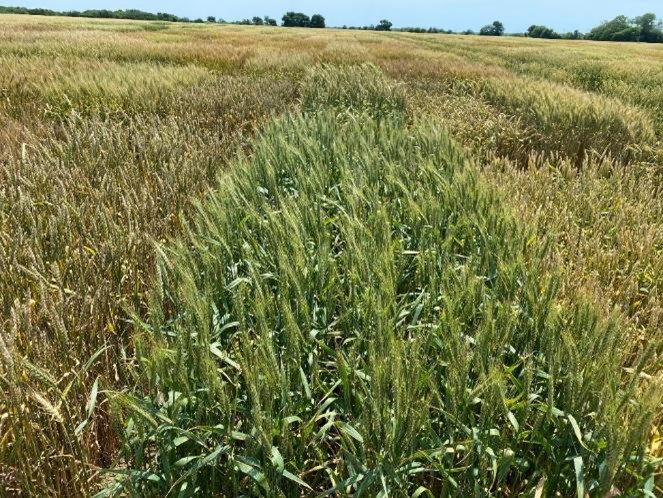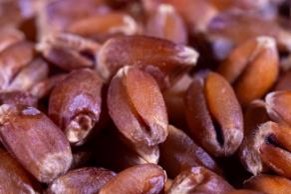Wheat Variety Development 2022
What stood out in 2022
Before an OSU experimental wheat line is commercially released, it must go through the third stage of statewide elite trial testing and usually for more than one year. This stage is called Oklahoma Elite Trial 3, or OET3, and comprises two subsets of lines with or without the Clearfield herbicide tolerance trait. By fall 2024, a third subset will be added to include elite lines fit for the CoAXium production system. Other Wheat Improvement Team (WIT) members, such as Meriem Aoun (supplemental disease assays), Liuling Yan (selected marker assays), Brian Arnall (targeted nitrogen schemes at Tipton) and Amanda Silva (testing at Alva) participate in the conduct of OET3 and other breeding nurseries.
Sites where the 2022 OET3 were successfully harvested are listed in Table 1. Two trials at Perkins and Goodwell were not harvestable, given the statewide persistent drought throughout the 2021-2022 season. The site yields of OET3 varied widely across Oklahoma — from 15 bu/ac at Alva to 67 bu/ac at Lahoma. The OET3 trial managed by WIT member Amanda Silva was moved from Kingfisher in 2021 to Alva in 2022, to fill a critical void in agronomic performance data in northwestern Oklahoma. This trial in 2022 missed one key precipitation event in early May, or it would have likely surpassed 30 bu/ac. The OET3 was returned to Alva for a second crop season in 2023-2024.
| Site | Mean Yield bu/ac | Top yielding entriesa Decreasing rank (left to right) |
||||
|---|---|---|---|---|---|---|
| Alva | 15 | Showdown | OK15DMASBx7 ARS 6-8 | |||
| Tipton low N (30 lb N) | 21 | OK18205-19HRBulk | ||||
| Tipton intermed N (45 lb N) | 27 | OK18510 | ||||
| Tipton full N (120 lb) | 37 | OK198509 | OK18510 | OK19225 | ||
| Okarche (unable to graze) | 32 | OK16103083 | OK15MASBx7 ARS 8-29 | OK18510 | AP Roadrunner | |
| Stillwater grazed | 46 | OK198509 | OK20418-7C21 | OK19225 | Showdown | |
| Chickasha | 58 | Showdown | ||||
| Morris | 62 | OK16107133-19HR-3 | OK20418-7C21 | |||
| Lahoma | 67 | OK18510 | OK15MASBx7 ARS 8-29 | |||
| Statewide | 41 | OK18510 | OK198509 | Showdown | OK19225 | OK18205-19HRBulk |
Note the stair-stepped progression in OET3 mean yield with each increment of nitrogen (N) added to the Tipton trials in mid-Feb. 2022 (Table 1). Lines which have high yield potential and can better tolerate N deprivation are desired. OK18205-19HRBulk was the better yielding entry at the low N level (25% of optimal) for the second consecutive year. This Greer derivative has been elevated to variety trial testing in 2023 for its greater potential to service southwestern Oklahoma dual-purpose wheat producers.
While OET3 yields were varied greatly across the state, some OET3 entries consistently ranked high for grain yield. These included, along with Showdown as a check, the experimental lines OK18510, OK19225 and OK198509 (Garrison/OK10519//Bentley). Interestingly, these three experimental lines have contrasting destinies. If released, OK18510 would be positioned for multi-purpose production statewide. OK19225 would be targeted for intensive wheat management systems with its very high yield ceiling but a more compromising disease package. OK198509 would be positioned as a dual-purpose variety east of I-35.
Shifting attention specifically to the High Plains production area of Oklahoma, three experimental lines have risen to the top of WIT’s consideration for resistance to wheat streak mosaic and Triticum mosaic (WSM/TM), both caused by viruses transmitted by the wheat curl mite (Table 2). Their approval is based on performance in curl mite-infested nurseries in Nebraska with strong to severe infections by WSM/TM. All three lines have provided protection equal to or exceeding that of Breakthrough, but the presence of gene wheat streak mosaic resistance gene Wsm1 alone or in combination with curl mite resistance gene Cmc4 has provided the highest and most consistent protection.
| Plant Yellowinga | Leaf chlorophyll indexb | Plant vigorc | |||||
|---|---|---|---|---|---|---|---|
| 2021 | 2022 | 2021 | 2022 | 2021 | 2022 | ||
| Candidate or Check | Genetics | 1-5 | % | ||||
| OK20D78S015 | Wsm1 | 0.0 | 0.0 | 50 | 48 | 100 | 90 |
| OK20D78S021 | Wsm2 + Cmc4 | 4.0 | 1.0 | 9 | 42 | 25 | 90 |
| OK21PS825 | Wsm1 + Cmc4 | 1.0 | - | 50 | - | 90 | - |
| Breakthrough | Resistant check | 1.5 | 1.5 | 39 | 43 | 80 | 70 |
| OK Corral | Susceptible check | 3.5 | 4.0 | 28 | 37 | 25 | 45 |
aYellowing: 1 = normal, 5 = dead; desired rating <2
bLeaf chlorophyll: <30, severe necrosis; ≥40, healthy green color; desired rating >40
cVigor: 0 = dead, 100% = normal plant growth; desired rating > 80%
No wheat variety grown in Oklahoma carries Wsm1 from Thinopyrum intermedium, or intermediate wheat grass, except OSU’s Breakthrough variety. Several varieties from Colorado State University or the Kansas State University-Hays breeding program carry either Wsm2 (from Triticum aestivum) or Wsm2 and Cmc4. Gene Wsm2 may not provide adequate protection against Triticum mosaic, even when paired with Cmc4. This was the suspected cause of increased susceptibility of OK20D78S021 in 2021 (Table 2). WIT does not endorse the deployment of Cmc4 alone for WSM protection, though varieties are plenty with that genotype.
While Wsm1 appears key to providing consistent and sufficient protection across WSM/TM severity levels in Oklahoma, linkage drag or reduction in fitness is more frequent with Wsm1 than Wsm2, even though all candidates in Table 2 were bred from genetic stocks produced at KSU and USDA-Agricultural Research Service (Manhattan) with reduced contribution of the Thinopyrum chromosome segment. The one weakness common to the candidate lines listed in Table 2 is stripe rust susceptibility, but this is likely not a consequence of the Thinopyrum chromosome segment. Thus, WIT’s aim is to improve upon this weakness. All candidates were placed under preliminary breeder seed increase and observation at Balko in fall 2022.
Resistance to stripe rust remains a top disease priority of WIT, even in years like 2022 where the disease was totally absent from field nurseries. This priority endures because of continuous collaboration with scientists at Washington State University and USDA-ARS (Pullman). WIT germplasm continues to show a high frequency of resistance to field levels of stripe rust infection in Washington that typically exceed levels experienced in Oklahoma (see 2022 Wheat Pathology report).
Using a multi-location index constructed from two types of disease ratings — one based on the type of symptom expressed and the other based on the intensity of symptom expression — extraordinary levels of stripe rust resistance were common among WIT advanced breeding lines. This was reflected in the index value reported for the entire OET3 in 2022 (with or without the Clearfield trait) in Figure 1. As specific examples of this level of resistance, OK Corral, Smith’s Gold and Big Country stood out among other varieties, including a common non-OSU variety touted as having resistance to stripe rust in Oklahoma. This classification may be overstated. Doublestop CL Plus, Showdown, Uncharted and Green Hammer perform well under typical stripe rust pressure in Oklahoma, though the most frequent stripe rust event in 2021 was overpowering in certain locations. WIT’s goal is to continue to move the pendulum of stripe rust resistance toward the level observed in OK Corral, Smith’s Gold and Big Country.
Figure 1. Disease index values for the 2022 OET3 nursery (Green Hammer data came from 2022 OET2) calculated from stripe rust infection type and severity of infection, collected at Central Ferry and Pullman, Washington in May-June 2023. (Data provided by K. Campbell, USDA-ARS, Pullman).
A look back to look forward
In the 2020 Partners in Progress Report, WIT reported on a 6-year project designed to estimate genetic gain in grain yield in Southern Plains wheat germplasm, using the number of generations removed from Turkey as the timeline rather than cultivar release date. Over six breeding cycles in dryland experiments conducted at Stillwater and Lahoma, grain yield increased 77% along a tight-fitting linear response curve. Thus, additional yield gains were expected in the absence of a plateau. Wheat protein concentration decreased 1.1% per breeding cycle, but the most advanced breeding cycles still maintained mean protein concentrations, exceeding the industry target of 12%. To gain a more direct understanding of yield and protein trends within the OSU variety development program, WIT also monitors genetic gains specifically within OET3 each year; however, in this case the data is collected statewide and in real time. This type of genetic gain is estimated on the go as each nursery is conducted year by year.
The results were shared publicly for the first time at the 2022 American Society of Agronomy annual meeting in a session chaired by WIT member Amanda Silva and International Maize and Wheat Improvement Center global wheat director Alison Bentley. Using the 1983 OSU release, Chisholm (as the long-term check variety) grain yield on a relative basis increased 0.5% per year (all lines in OET3) or 0.8% per year (highest yielding line in OET3 each year) (Figure 2). Other than at the beginning of this time course, relative yields fell below the regression line or were short of expectation in four of the past five years. This phenomenon likely reflected relatively poor adaptation of WIT elite lines in the presence of a significant spring freeze (2018), unusually high Septoria tritici blotch infection (2019 and 2020) or chronic drought (2022). Fungicide application has not been employed in the OET3 except at Morris.
Genetic gain for wheat protein as a percent of the long-term check also increased in the past decade (Figure 3). This positive change is more remarkable given the baseline for comparison is Chisholm, a moderately high wheat protein variety. Its long-term mean over this period was 12.9%. Further, trends for the highest-protein line and the entire nursery were parallel, a favorable result that would indicate forward progress in the nursery as a whole. This will continue to raise the protein ceiling in WIT germplasm. On the other hand, inspection of the highest protein data points in the past seven years would indicate the contrary – that OET3’s maximum wheat protein level appears to be flattening at 105 to 110% of Chisholm’s protein level or at 14% wheat protein on an absolute basis, which is two points above the hard red winter (HRW) class standard of 12%. Nevertheless, a 14% protein ceiling provides a comfortable cushion in years where the overall crop protein might plummet.
Figure 2. Genetic gain (∆G) for grain yield in OET3 from 1998 to 2022 based on percent of the long-term check variety Chisholm for either all experimental lines or the top yielding line in the nursery each year.
Figure 3. Genetic gain (∆G) for wheat protein concentration in OET3 from 2010 to 2021 based on percent of the long-term check variety Chisholm for either all experimental lines or the top protein line in the nursery each year.
Candidate varieties waiting for the launch pad
The first three candidates listed in Table 3 have already undergone three years of foundation seed increase and purification and are eligible for release in the first quarter of 2023. Potential end-users, such as millers and bakers, continue to evaluate the grain produced from all three “OX”wheat candidates to assess the value associated with removing dough improvers and other chemical additives, as well as reducing – if not eliminating – vital wheat gluten from bread product formulations. The valuation process has been multifaceted and remains ongoing, partly because there is no HRW precedent for the dough strength inherent to these candidates. If commercialization proceeds, the germplasm will require more stringent protection by patent instead of a plant variety certificate to ensure varietal purity, maintain value and prevent leakage of the grain into commodity HRW channels with a vastly different expectation of functionality. Though the three candidates are classified as HRW, their functionality is closer to hard red spring (HRS). Before these candidates, Baker’s Ann was considered WIT’s crown jewel for dough strength, but it was never captured throughout the wheat supply chain.
The launch of this germplasm will represent a first-time opportunity to change the face of HRW wheat production and utilization in the bulk of the southern Plains (Texas to southern Kansas). This goes far beyond the hard white (HW) production and utilization that occurred with adoption of the variety Snowmass in Colorado and the High Plains. The critical answer lacking at this point – and the subject of future research in collaboration with Kansas State University – is how we got here. It is not known if the enormous leap in dough strength was driven by the Bx7oe glutenin subunit donor, Snowmass, or by the recipient background (Gallagher) or the combination or genetic interaction between the two. While fascinating, this knowledge void is even more tantalizing because future progress from breeding in this uncharted functionality space hinges on the answer.
Other candidates summarized in Table 3 with a likely launch in 2023 are OK18510, OKP17D101A666 and OK198417C. Candidate OK18510 exhibits unusually wide adaptation throughout Oklahoma and resilience under multiple forms of stress, including grazing. Its genetic background beams with diversity and is centered on a Pioneer HRW foundation (Figure 4). Like Butlers’ Gold, candidate OKP17D101A666 exhibits a rapid maturity pattern from first hollow stem to senescence that makes it suited for short-season production systems. Candidate OK198417C has emerged as the leading Clearfield successor to Doublestop CL Plus and Strad CL Plus. A substantial improvement in test weight over Doublestop CL Plus was not expected from any part of the variety development program in the foreseeable future until this line emerged.
| Candidate | Pedigree | Years | Brief Description |
|---|---|---|---|
| OK15MASBx7 ARS 8-20 (OX) | Gallagher*3/ Snowmass | 3 | HRS dough in a HRW kernel; statewide adapted; WSBM-R |
| OK15MASBx7 ARS 8-29 (OX)a | Gallagher*3/ Snowmass | 3 | HRS dough in a HRW kernel; statewide adapted; WSBM-S |
| OK15DMASBx7 ARS 6-8 (OX) | OK10130*3/ Snowmass | 3 | HRS dough in a HRW kernel; adapted central corridor |
| OK16107133-19HR-3b | Duster Diamond/Doublestop CL+ | 1 | Not CL+; preferred choice, but less FS; marginal quality |
| OK16107133-19HR-4 | Duster Diamond/Doublestop CL+ | 2 | Not CL+; lacks BYD immunity; inferior quality |
| OK16107125C-17HR-2 | Duster Diamond/Doublestop CL+ | 3 | CL+; BYD immunity (same as Uncharted) |
| OK198417C | OK10943C/OK09935C//Doublestop CL+ | 3 | CL+; better yield, test wt., stripe rust than Doublestop CL+ |
| OK18510 | TCI982345/Ruby Lee//OK10415 | 2 | Highest yield-ranking experimental past 5 yr; possible replacement for Showdown, Green Hammer, Smith’s Gold |
| OK19225 | KS06O3A~58-2/OK10408//Ruby Lee | 2 | Targeted for IM systems with plant growth regulator to suppress height; top-end yield |
| OK16103083 | Garrison*3/Wesley Fhb1-106 | 2 | Garrison with head scab resistance for eastern, NC OK |
| OKP17D101A666 | HV9W07-1031/Gallagher //OK09429 | 1 | Short-season; step change in yield from Butler’s Gold |
| OK21227 | MD01W233-06-1/Gallagher//OK13216 | 1 | Beardless; panoptic improvement over OK Corral |
| OK18205-19HRBulk | Greer/OK09729 | 1 | For SW OK; novel leaf rust R; tolerates grazing, lower N |
aTwo additional and improved sib lines on foundation seed increase
bFour additional sib lines on foundation seed increase with closer quality to Doublestop CL+.
Figure 4. Beginning with wheat field days in spring 2023, wheat producers across the state will have access to a unique infographic for each of the 10 OSU wheat varieties. These single-page documents will summarize each variety with a set of breeder’s bullets, key statistics and other descriptive information. A genealogy map will be created that looks like the one below for candidate variety OK18510, which is also featured in Table 3 of this report.
2022 Hotspots and Snapshots
Figure 5. The CoAXium component of the OSU wheat improvement program featured two seed increase nurseries in 2022, one at Yuma, Arizona (top) involving 139 marker-confirmed, two-gene AX doubled haploids (DHs) and the other at Lahoma (bottom) involving 468 AX conventional inbreds with a 1x application of Aggressor herbicide. CoAXium nurseries in 2023 will enable WIT to identify two-gene experimental lines in each group for statewide yield testing and AXigen confirmation trials required for variety release. Carver will likely prioritize the DH lines in the first wave of candidate variety selection, particularly those with mutations for herbicide tolerance in the A and D genomes. Critical to this breeding process was genotypic selection provided by WIT member Liuling Yan and his associate, Ragu Nagarajan. Phenotypic selection was facilitated by former WIT member Misha Manuchehri.
Figure 6. About 650 bulk populations in the F4 generation, or four inbreeding generations following the cross, were evaluated at Okarche (grazing wheat) and Lahoma (grain-only) in 2022 as part of the GrazenGrain® breeding scheme. Head selections are typically made at this intermediate stage of the 10-year conventional breeding cycle to initiate experimental line development and eventual testing. Shown is one F4 population resulting from the cross, Smith’s Gold x Uncharted. This population was especially noteworthy for its drought tolerance in 2022. Note the segregation for chaff color, as expected. Each plant in this population is genetically different, providing the diversity needed to produce genetically unique experimental lines, one of which could become a commercial variety in five to six years.
Figure 7. Candidate variety OK15MASBx7 ARS 8-29 is better known for its uniquely superior dough strength more aligned with hard red spring wheat than hard red winter. This genotype also has exhibited top-end yield potential and resilience to multiple challenges in Oklahoma, such as fungal disease pressure, Hessian fly and chronic drought stress. Pictured on the left is OK15MASBx7 ARS 8-29 under severe simulated grazing stress in the drought-challenged year of 2022 on May 18. Pictured on the right is OK15MASBx7 ARS 8-29 in the OCES wheat variety trial at Lahoma on May 29, 2022, where it placed in the top-yielding group at 85 bu/ac among 51 entries. OK15MASBx7 ARS 8-29 yielded the same as Showdown in this trial and is expected to yield at the Showdown level across the western two-thirds of Oklahoma. Parentage of OK15MASBx7 ARS 8-29 is approximately 88% Gallagher and 12% Snowmass.
Figure 8. Two candidate varieties that emerged from 2022 testing are OK16108083 and OKP17D101A666, shown on the left and right as they appeared on May 20, 2022 under severe simulated grazing stress and drought stress at Stillwater. Note their wide disparity in maturity. This difference signifies the complete range of maturity pattern in the wheat improvement program. The very late maturing OK16108083 (88% Garrison by pedigree) will be considered for release in 2023 for its genetically high level of Fusarium head blight, or head scab, resistance conferred by gene Fhb1 and other minor genes quantitative trait loci. Its later maturity may provide added protection to this disease and to spring freeze events. The naturally early maturing OKP17D101A666 was close to harvest maturity on May 20, even earlier than Butler’s Gold, in Stillwater and elsewhere in Oklahoma. Its accelerated reproductive development pattern, vernalization requirement, yield potential and disease protection package make it highly suited to delayed planting in a short-season management system. WIT has initiated genetic pipeline development for short-season adaptation using this variety, Butler’s Gold and others as progenitor germplasm.
Figure 9. The 2022 wheat harvest produced four beardless experimental lines worthy of candidate variety status. Featured below on the right is OK21227, the leading candidate for its exceptional disease resistance portfolio, including stripe rust resistance exhibited on May 3, 2021 at Tipton. OK21227 has parentage from University of Maryland, Gallagher and an OSU experimental line derived from Endurance, Fuller and Billings. OK21227 would be targeted for the same area as OK Corral but with higher yield and test weight potential. Another of the four beardless candidates moving forward in 2023 is OK21PS821 (not pictured). It could be WIT’s first graze-out or hay-only beardless variety. Conducive to this purpose is extremely tall stature with good straw strength, very late maturity and comprehensive disease protection. Its large kernel size, high test weight and high yield potential would still make OK21PS821 worthy of grain production.
Figure 10. A five-year behind-the-scenes research effort culminated in 2022 with the identification of eight novel and well adapted WIT lines featuring elevated anthocyanin levels. Anthocyanins are phenolic pigment compounds that impart red, purple and blue colors to certain foods. They provide antioxidant, anti-inflammatory, hypoglycemic and other favorable outcomes for human health. Vegetables and fruits are more often considered our primary dietary source of anthocyanins. Wheat grass (Thinopyrum spp.) has played a crucial role in providing disease resistance to OSU varieties, such as Breakthrough and Uncharted. Certain accessions can also lend a purple pericarp (middle) or blue aleurone, thus showing greater concentrations of anthocyanins than red wheat.
Those eight novel experimental lines were created using familiar varieties like Smith’s Gold and Big Country in the background of a cross with a Romanian purple wheat accession. One of those purple pericarp lines is shown (top) in the field at Okmulgee on May 28, 2022. Wholemeal extracts from this purple wheat and a white wheat sibling reveal the characteristic colors in proportion to their anthocyanin levels (middle). Phytochemical analysis of this germplasm was conducted by undergraduate scholar Georgia Eastham under the tutelage of Dr. Edralin Lucas, professor in the OSU Department of Nutritional Sciences. This work was featured in a SUNUP interview in 2021. WIT’s objective in 2023 will be to identify the best combination of agronomics, end-use quality and nutritional quality among the eight lines to justify commercialization.
Figure 11. Selection for low pH tolerance, or acid soil tolerance, occurs annually at the Perkins location for most preliminary, intermediate and advanced experimental lines. Shown are single-row, 10-ft plots, in which the first row of a four-row set is the check variety, Strad CL+, and the other three rows contain three experimental lines. It is important to note that ratings released by WIT pertain to this location, this level of soil acidity (pH from 4.5 to 4.9) and this level of aluminum saturation (~15-30%). Ratings taken at higher pH or lower aluminum saturation levels may be more forgiving. Also, drought stress may accentuate sensitivity to low pH. Thus, a minimum of three years is preferred to arrive at a confident rating. Molecular markers for genes other than ALMT1 do not add significant confidence to those ratings.
About 50% of the non-Clearfield advanced lines evaluated in 2022 were rated as moderately tolerant or better. This is consistent with the frequency in more recent years. All 18 Clearfield advanced lines were rated as tolerant or very tolerant. This disproportionate frequency reflects the more favorable genetic background in which the CL trait is currently housed.
Figure 12. The South Central Research Station at Chickasha has filled a glaring geographic gap in WIT field testing since 2017. The 2021-2022 crop season featured nearly 2,500 yield and quality plots at Chickasha (see below for UAS photo by WIT member Brian Arnall). Though not the case in 2022, the Chickasha site often can be counted on as a reliable environment for disease evaluation, particularly for leaf rust and stripe rust. Included at this site almost annually is a 250-plot nursery provided by Corteva (Pioneer) for evaluation of their F1 hybrids, sometimes involving OSU parentage.
Figure 13. Selection by WIT for wheat streak mosaic (WSM) and Triticum mosaic (TM) resistance is accomplished by genetic markers and then validated with phenotypic screening in field inoculated nurseries near Mead, Nebraska, in cooperation with the University of Nebraska–Lincoln. In 2023, this nursery will be moved temporarily to a site in western Kansas in cooperation with USDA-ARS. Three candidate varieties with varying levels of dual resistance to WSM and TM were found in this nursery and will be extensively evaluated in Oklahoma in 2023 (see Table 2). Preliminary breeder seed increase will occur near Balko in 2023. This germplasm is expected to soon provide alternatives or replacements for Breakthrough, released by Oklahoma Ag Research in 2020.






